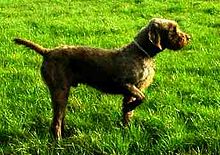
The Wirehaired Pointing Griffon is a breed of dog used in hunting as a gundog. It is sometimes considered to be Dutch in ancestry, due to the nationality of the breed founder, Eduard Karel Korthals. History records the progression of the development of the breed through Biebesheim am Rhein, Germany where the founder established the Ipenwoud kennel and the breed type was established and then into France where it is now recognized. Others consider the Griffon to be a German breed because Korthals' kennel, Ipenwoud, was located in Biebesheim am Rhein, Germany. It was there for over twenty years that Korthals dedicated his life to the development and perfection of the Korthals Griffon.
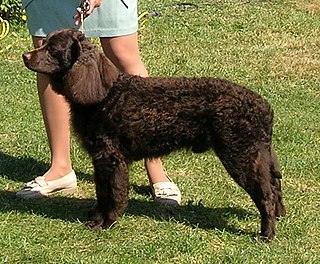
The American Water Spaniel is a breed of spaniel which originated in the United States. It was developed in the state of Wisconsin during the 19th century from a number of other breeds, including the Irish and English Water Spaniels. The breed was saved by Dr. Fred J. Pfeifer, who set up the breed club and standard, and whose work led to recognition for the breed by the United Kennel Club, and later, the American Kennel Club. While they are the state dog of Wisconsin, they remain a rare breed.

The Barbet is a breed of dog; it is a medium-sized French water dog. It is listed in Group 8 by the Société Centrale Canine, the French Kennel Club and the Fédération Cynologique Internationale.

The Poodle, called the Pudel in German and the Caniche in French, is a breed of water dog. The breed is divided into four varieties based on size, the Standard Poodle, Medium Poodle, Miniature Poodle and Toy Poodle, although the Medium Poodle is not universally recognised. They have a distinctive thick, curly coat that comes in many colors and patterns, with only solid colors recognized by breed registries. Poodles are active and intelligent, and are particularly able to learn from humans. Poodles tend to live 10–18 years, with smaller varieties tending to live longer than larger ones.
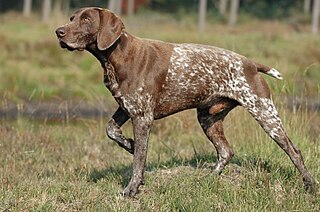
The German Shorthaired Pointer is a breed of medium-sized pointing dog developed in nineteenth century Germany. It is energetic and powerful, with strong legs and great endurance. It is a versatile all-purpose gun dog suitable for hunting and retrieving on both land and water, with a strong drive to find and chase game. It may also be kept as a companion dog, though as a high-energy sporting dog, it requires significant amounts of exercise.

The German Wirehaired Pointer is a medium to large-sized griffon type breed of dog developed in the 19th century in Germany for versatile hunting. It became a leading gun dog in Germany in the later part of the 20th century. It is the result of the careful mixing and crossing of the Wirehaired Pointing Griffon, German Shorthaired Pointer, German Roughhaired Pointer, and the hunting Pudelpointer in the late 19th century.

Gun dogs, or bird dogs, are types of hunting dogs developed to assist hunters in finding and retrieving game. The term hunting dog is broad and includes all breeds and skills of hunting canines, but "gun dogs" refers to canines that are trained to work alongside a loud firearm while hunting or retrieving game. Gun dogs are divided into three main categories: pointers and retrievers, setters and spaniels, and water dogs.
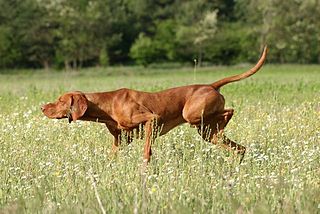
Pointing dogs, sometimes called bird dogs, are a type of gundog typically used in finding game. Gundogs are traditionally divided into three classes: retrievers, flushing dogs, and pointing breeds. The name pointer comes from the dog's instinct to point, by stopping and aiming its muzzle towards game. This demonstrates to the hunter the location of their quarry and allows them to move into gun range. Pointers were selectively bred from dogs who had abundant pointing and backing instinct. They typically start to acquire their hunting instincts at about 2 months of age.
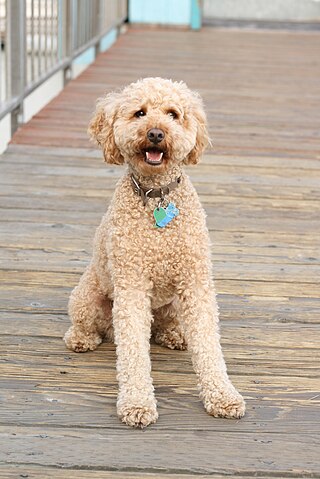
Dog crossbreeds, sometimes called designer dogs, are dogs which have been intentionally bred from two or more recognized dog breeds. They are not dogs with no purebred ancestors, but are not otherwise recognised as breeds in their own right, and do not necessarily breed true.

The Drentsche Patrijshond is a versatile spaniel-type hunting dog from the Dutch province of Drenthe. Called the Dutch Partridge Dog in English, approximately 5,000 dogs are registered with the breed club in the Netherlands, and breed clubs operate in Belgium, Denmark, Scandinavia and North America. The Drentsche Patrijshond bears some resemblance to both spaniel and setter types of dog. An excellent pointer and retriever, this dog is often used to hunt fowl and adapts equally well to the field or marshes.

The Irish Water Spaniel is a breed of dog that is the tallest of the spaniels.

The Small Münsterländer is a versatile hunting-pointing-retrieving dog breed that reached its current form in the area around Münster, Germany. The Large Münsterländer is from the same area, but was developed from different breeding stock and is not related as the names would suggest. Small Münsterländers bear a resemblance to both spaniels and setters but are more versatile while hunting on land and water. The Small Münsterländer is recognized by the Fédération Cynologique Internationale under Group 7, Section 1.2, Continental Pointing Dogs of Spaniel type, by the American Kennel Club as a Foundation Stock Service breed, and by The Kennel Club and the United Kennel Club as a gun dog. It is related to the Epagneul Français and the Drentsche Patrijshond.
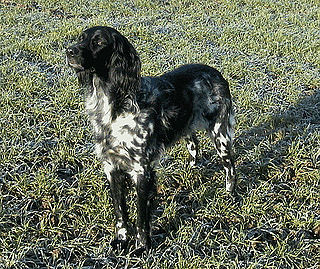
The Large Münsterländer is a breed of gun dog originally from the Münster region in Germany.

The German Longhaired Pointer (GLP) is a breed of dog. Developed in Germany, it is used as a multipurpose gundog. It is closely related to its cousins, the German Shorthaired Pointer (GSP), the German Wirehaired Pointer (GWP) and the Large Münsterländer, which was previously part of the breed.
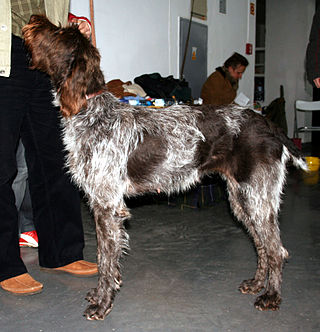
The Český Fousek is a Czech breed of versatile hunting dog that was traditionally and currently used to hunt, point, and retrieve. This refers to the dog's natural ability in tracking, pointing, and retrieving game. The name is in Czech, in which český means Czech and fousek is derived from vousy or vousky (whiskers). While the name is used for both sexes, Český Fousek specifically refers to a male dog while the female is traditionally called Česká Fouska. The breed is part of the griffon hunting dog family and have the beard and moustache common to wirehairs. There is a large difference in size between the females and males of this breed, with the weight difference being up to 11 kilograms (24 lb).

The German Spaniel, also known as the Deutscher Wachtelhund, is a breed of dog that was developed in Germany around 1890, and is used as a hunting dog. Descended from the old German breed, the Stöberer, which became popular with commoners following the Revolutions of 1848 in the German states, who required a versatile hunting dog. Stoeberer is now a type of hunting dog in Germany with the Wachtelhund being its sole member. The breed is not very well known outside of Germany, but was recognised by the United Kennel Club in 1996.

The Braque d'Auvergne is a breed of dog originating in the mountain area of Cantal, in the historic Auvergne province in the mid-south of France. It is a pointer and versatile gundog. The breed descends from ancient regional types of hunting dogs.

The Slovak Rough-haired Pointer is a gundog breed developed after World War II in Slovakia. It is known by many confusingly similar names in English, including the Slovak Wirehaired Pointer, the Slovak Pointing Griffon, the Slovak Wirehaired Pointing Griffon, and the Slovak Wirehaired Pointing Dog. Its closest relative is the Bulgarian Hound.

The Hungarian Wirehaired Vizsla is the English name of the Drótszőrű Magyar Vizsla, a dog breed originating in Hungary, with the name translating directly as Hungarian wirehaired pointer. The English plural is vizslas or sometimes vizslak, based on the Hungarian plural vizslák ).

The Dalmatian is a breed of dog, which has a white coat marked with black or brown-coloured spots. Originating as a hunting dog, it was also used as a carriage dog in its early days. The origins of this breed can be traced back to present-day Croatia and its historical region of Dalmatia. It is thought that early ancestors of the breed were certain breeds of pointers and a spotted Great Dane. Today, it is a popular pet and many enthusiasts enter Dalmatians into kennel club competitions.
